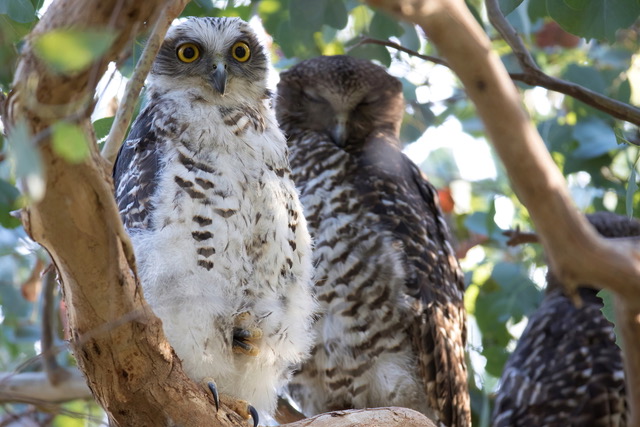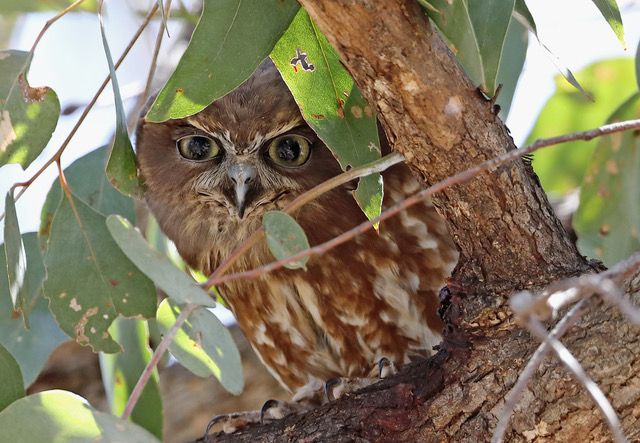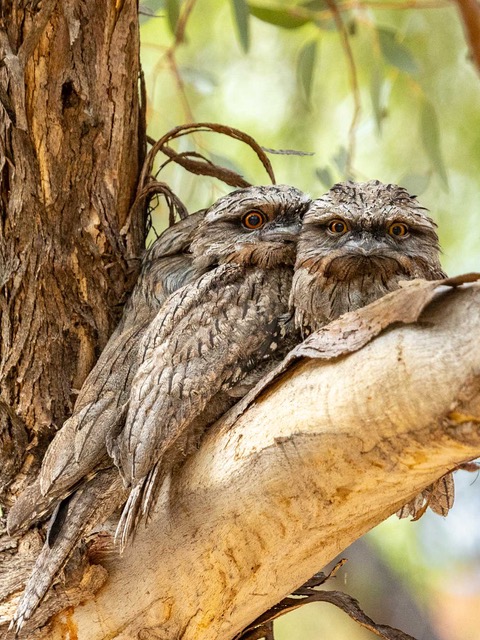by Joe Eaton

(Full article from RATS Tales October 2023)
Articles in peer-reviewed scholarly journals don’t usually end with calls to action. But a paper that recently appeared in Science of the Total Environment does just that. Raylene Cooke of Deakin University in Geelong, Australia and her co-authors describe widespread exposure to second-generation anticoagulant rodenticides (SGARs) in three Australian owl species—powerful owls, southern boobooks, and barn owls—and an unrelated nightbird, the tawny frogmouth. In a country where SGAR sales and use are essentially unrestricted, they recommend significant regulatory changes and extensive monitoring of wildlife for AR contamination.
Southern boobooks are Australia’s smallest owls, between the size of a screech-owl and a short-eared owl, whose prey includes rodents, small marsupials, lizards, frogs, birds, and insects. At the other end of the size range, powerful owls, comparable to great horned or snowy owls, are specialist predators of tree-dwelling marsupials like brushtail and ringtail possums (distant kin of American opossums) and gliders (the marsupial version of flying squirrels.) The barn owls in the sample are similar to populations in the Americas, Eurasia, and Africa; Australian scientists consider them a distinct species, the eastern barn-owl. Like their counterparts elsewhere, they’re mainly rodent-eaters. Muppet-like tawny frogmouths have some owl-like trails—nocturnal habits, cryptic plumage—but are more closely related to nightjars (like the American nighthawks and whip-poor-wills), swifts, and hummingbirds. Insects predominate in their diet, supplemented by small vertebrates.

The owls and frogmouths in the new study were found dead or dying between 2003 and 2022, mainly in the southeastern state of Victoria. Of the 60 birds, 92 percent had been exposed to at least one AR, 38 percent to multiple ARs. Concentrations with potentially clinical or lethal effects were found in 80 percent of the barn owls, 68 percent of the frogmouths, 42 percent of the boobooks, and 33 percent of the powerful owls. The SGAR brodifacoum was present in all the exposed birds. Exposure to the SGAR bromadiolone was also high (80 percent) in barn owls. The only FGAR detected was pindone, in low concentrations in powerful owls. The researchers found no relationship between exposure and land use; both urban and rural birds were affected. (Michael Lohr previously reported extensive SGAR contamination in boobooks in Western Australia. Diurnal raptors aren’t exempt: ARs have also been found in wedge-tailed eagles in Tasmania.)
The fact that four species with diverse foraging strategies have been heavily exposed to SGARs suggests multiple contamination pathways. Boobooks and barn owls are likely consuming target rodents, But boobooks also eat reptiles, and Lohr has documented ARs in several Australian snake and lizard species. Although a few powerful owls in urban settings have been known to eat rats, they’re exceptions to the species’ usual prey. While most of the marsupials they consume are leaf-eaters, brushtail possums have a broader diet range, including bird eggs, food scraps, and (in captivity) meat. One reference describes them as “frequently cohabiting with humans,” often denning in roof cavities where they might encounter AR bait left for rats. Intentional poisoning of possums can’t be ruled out. The presence of the FGAR pindone, a rabbit poison, in some powerful owls suggests the birds are also hunting or scavenging rabbits, or that brushtails are eating rabbit bait. The frogmouths may be picking up the occasional poisoned mouse, or invertebrates that have eaten AR baits. Although so far not documented in Australia, exposure via invertebrates has been reported or suspected in New Zealand (birds and bats) and Europe (birds and hedgehogs.)

“Management of these poisons will require considerable and concerted actions to limit both non-target poisoning and secondary poisoning,” Cooke and her co-authors conclude. Specific suggestions include requiring tamper-proof bait stations, restricting SGAR sales to pest control professionals, and confining the use of ARs to indoor areas. Noting a dearth of exposure data, they also recommend a national monitoring program similar to the one in the United Kingdom, funded by a rodenticide sales tax. The article reinforces a growing movement pushing for reform of Australia’s dysfunctional and scandal-plagued national pesticide regulatory agency; more about that in a future newsletter.
